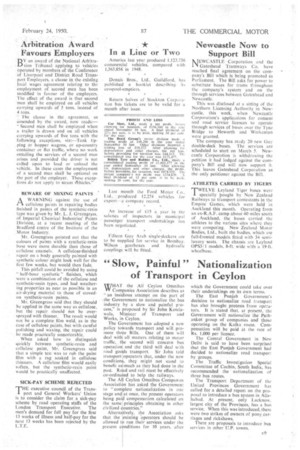Arbitration Award Favours Employers
Page 43

If you've noticed an error in this article please click here to report it so we can fix it.
By an award of the National Arbitration Tribunal applying to vehicles Operated by members of the Conference of Liverpool and District Road Transport Employers, a clause in the existing local wages agreement relating to the employment of second men has been mOdified in favour of the employers. The effect of the award is that second men shall be employed on all vehicles carrying upwards of 5 tons, instead of•4 tons,
'r The clause in the agreement, as amended by the award, now reads:— " Second men shall he employed when a trailer is drawn and on all vehicles carrying upwards of ifixie tons with the following exceptions, viz:---Tank tip. ping or hopper wagons, or up-country ecintainer or flat traffic, where no work entailing the services of it second man arises and provided the driver is not called upon to load or unload the vehicle, in these cases the employment of a second man shall be optional on the part of the employer. These exceptions do not apply to steam 17bhicles."
BEWARE OF MIXING PAINTS
AWARNING against the use of cellulose paints in repairing bodies finished in paints of the synthetic-resin type was given by Mr. L. J. Greengrass. of Imperial Chemical Industries' Paints Division, at a 'recent meeting of the Bradford centre of the Institute of the Motor Industry.
Mr. Greengrass pointed out that the colours of paints with a synthetic-resin base were more durable than those of cellulose enamels. A cellulose-finished repair on a body generally painted with synthetic colour might look well for the first few weeks, but would then fade_ This pitfall could be avoided by using " half-hour synthetic " finishes, which were a combination of the cellulose and synthetic-resin types, and had weathering properties as near as possible in an air-drying material to those of stovedon synthetic-resin paints.
Mr. Greengrass said that they should be applied in the same way as cellulose, but the repair should not be oversprayed with thinner. The result would not be a complete film weld, as in the case of cellulose paints, but with careful polishing and waxing, the repair could . be made practically unnoticeable.
. When asked how to distinguish quickly between synthetic-resin and cellulose paint, Mr. Greengrass said that a simple test was to rub the paint film with a rag soaked in cellulose thinners. A cellulose film would easily soften, but the synthetic-resin paint would be practically unaffected.
SICK-PAY SCHEME REJECTED
THE executive council of the Trans' port and General Workers' Union is to consider the claim for a sick-pay scheme by road operating staffs of the London Transport Executive. The merrs demand for full pay for the first 13 weeks of illness and half-pay for the next 13 weeks has been rejected by the L.T.E.




































































































